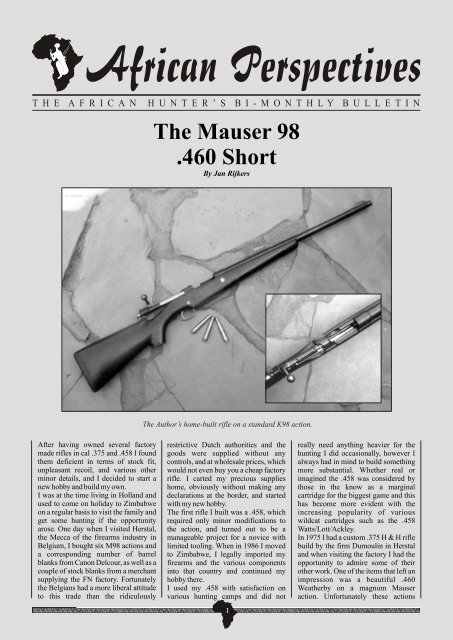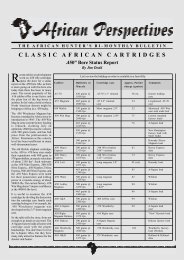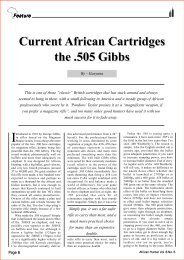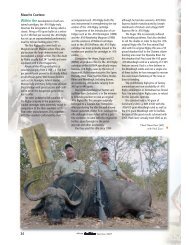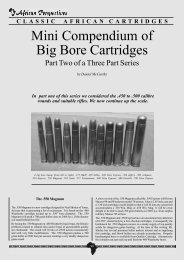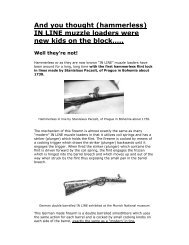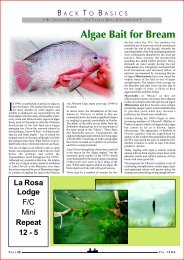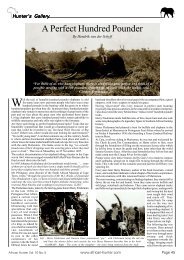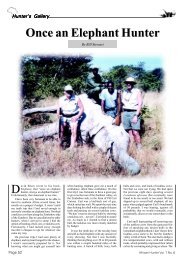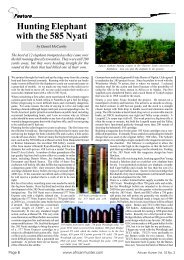AFRICAN PERSPECTIVES VOL 8#1 - HuntNetwork
AFRICAN PERSPECTIVES VOL 8#1 - HuntNetwork
AFRICAN PERSPECTIVES VOL 8#1 - HuntNetwork
Create successful ePaper yourself
Turn your PDF publications into a flip-book with our unique Google optimized e-Paper software.
African Perspectives<br />
THE <strong>AFRICAN</strong> HUNTER’S BI-MONTHLY BULLETIN<br />
After having owned several factory<br />
made rifles in cal .375 and .458 I found<br />
them deficient in terms of stock fit,<br />
unpleasant recoil, and various other<br />
minor details, and I decided to start a<br />
new hobby and build my own.<br />
I was at the time living in Holland and<br />
used to come on holiday to Zimbabwe<br />
on a regular basis to visit the family and<br />
get some hunting if the opportunity<br />
arose. One day when I visited Herstal,<br />
the Mecca of the firearms industry in<br />
Belgium, I bought six M98 actions and<br />
a corresponding number of barrel<br />
blanks from Canon Delcour, as well as a<br />
couple of stock blanks from a merchant<br />
supplying the FN factory. Fortunately<br />
the Belgians had a more liberal attitude<br />
to this trade than the ridiculously<br />
The Mauser 98<br />
.460 Short<br />
By Jan Rijkers<br />
The Author’s home-built rifle on a standard K98 action.<br />
restrictive Dutch authorities and the<br />
goods were supplied without any<br />
controls, and at wholesale prices, which<br />
would not even buy you a cheap factory<br />
rifle. I carted my precious supplies<br />
home, obviously without making any<br />
declarations at the border, and started<br />
with my new hobby.<br />
The first rifle I built was a .458, which<br />
required only minor modifications to<br />
the action, and turned out to be a<br />
manageable project for a novice with<br />
limited tooling. When in 1986 I moved<br />
to Zimbabwe, I legally imported my<br />
firearms and the various components<br />
into that country and continued my<br />
hobby there.<br />
I used my .458 with satisfaction on<br />
various hunting camps and did not<br />
I<br />
really need anything heavier for the<br />
hunting I did occasionally, however I<br />
always had in mind to build something<br />
more substantial. Whether real or<br />
imagined the .458 was considered by<br />
those in the know as a marginal<br />
cartridge for the biggest game and this<br />
has become more evident with the<br />
increasing popularity of various<br />
wildcat cartridges such as the .458<br />
Watts/Lott/Ackley.<br />
In 1975 I had a custom .375 H & H rifle<br />
build by the firm Dumoulin in Herstal<br />
and when visiting the factory I had the<br />
opportunity to admire some of their<br />
other work. One of the items that left an<br />
impression was a beautiful .460<br />
Weatherby on a magnum Mauser<br />
action. Unfortunately these actions
African Perspectives<br />
C U R R E N T<br />
A F R I C A N<br />
Left to right - the .460 Short, .460 Weatherby Magnum,<br />
.458 Win Mag and the .458 Lott<br />
were no longer available and even<br />
second hand were virtually impossible<br />
to obtain.<br />
Being awash in standard M98 actions I<br />
therefore decided that I had to use what<br />
was available and choose a cartridge<br />
that would function in this action.<br />
The action chosen is a military Mauser<br />
coded 243 (Erfurt) and made in 1940.<br />
Interestingly it probably saw action in<br />
the second World War and also has a<br />
small Star of David on the receiver ring<br />
indicating that it was used by the Israeli<br />
army in the first Arab war of 1948, in<br />
both cases obviously in caliber<br />
8x57mm.<br />
At first I considered a wildcat based on<br />
the 404 case but found the cost and<br />
hassle of getting a chambering reamer<br />
and custom die set too much of a<br />
deterrent. I then decided to shorten the<br />
.460 Weatherby so that it could be made<br />
to function in the standard length<br />
action.<br />
Although it is possible to modify the<br />
M98 action to accept a .375 H&H or<br />
similar length cartridge I believe this<br />
practice weakens the action<br />
considerably as most of the gain comes<br />
from removing material from the rear of<br />
the bottom locking lug area.<br />
I therefore settled on a case length of<br />
2.6" (66mm), which is 0.1" longer than<br />
the .458 and 0.32" shorter than the .460,<br />
and requires only minor metal removal<br />
from the critical area of the feed ramp.<br />
As the .460 Weatherby case has only<br />
minimal body taper it proved possible<br />
to use a standard chambering reamer.<br />
Similarly reloading dies can be made by<br />
shortening the standard dies, recutting<br />
the belt recess, and polishing a radius at<br />
the bottom of the sizer die.<br />
After contouring and chambering the<br />
barrel, and making some dummy<br />
cartridges I could start work to modify<br />
the action to function with this large<br />
diameter cartridge. This proved to be<br />
more of an obstacle than anticipated and<br />
after a fruitless search for a suitable<br />
magazine/floorplate assembly I<br />
eventually had to make my own, which<br />
turned out to be the most time<br />
consuming part of the whole project.<br />
I do not believe in the necessity of an<br />
opening floorplate, which is further<br />
reinforced by the vivid memory of<br />
being charged by an enraged elephant<br />
and having the contents of the magazine<br />
dumped at my feet. Therefore the<br />
floorplate was made solid, which also<br />
simplified the machining.<br />
After enlarging and deepening the bolt<br />
face and adjusting the extractor to fit the<br />
case rim, and removing material from<br />
the guide rails I eventually got the<br />
action to feed from the magazine.<br />
With hindsight it would have been a<br />
better solution to remove the belt from<br />
the cases which would improve feeding<br />
and make adjustment of the action a<br />
little easier, however as I had already<br />
chambered the barrel and modified the<br />
dies I decided to leave this mod for the<br />
next time.<br />
Fitting the frontsight ramp and a banded<br />
rearsight base with an integral recoil lug<br />
completed the metal work.<br />
The stock was made from imbuia, also<br />
erroneously known as Brazilian walnut,<br />
II<br />
C A R T R I D G E S<br />
and which is substantially heavier than<br />
walnut, and fitted with the largest<br />
available pachmayer recoil pad.<br />
When developing the load I found that<br />
the case would hold a maximum of 105<br />
grains of powder, and I have recorded<br />
muzzle velocities of 2560 with a 500<br />
grain FMJ. However, for regular use I<br />
have settled on a load of 100 grains of<br />
Somchem powder giving 2350 ft/sec, at<br />
very moderate pressures, and long case<br />
life.<br />
A variety of cast bullet loads were tried<br />
out but I found that only a 600 grain<br />
from a self made mould would shoot to<br />
the same point of impact. The load I<br />
found useful for cheap practice consists<br />
of 65 grains of S335, which gives this<br />
bullet a velocity of 2000 ft/sec.<br />
When designing a rifle, or any other<br />
object for that matter, one tries not to<br />
imitate the regular monotonous factory<br />
product, with its real or perceived<br />
shortcomings, but to produce<br />
something that the cartridge is a<br />
wildcat, by having a stepped barrel, a<br />
rear sight base with a large barrel band<br />
and integral recoil lug, and a stock of an<br />
unusual timber that is designed to fit the<br />
user and is very comfortable with the<br />
heavy recoil.<br />
The down side is that, due to the heavy<br />
floor plate and high density of imbuia<br />
stock, the rifle is at 11 pounds a bit<br />
heavier than intended.<br />
Although I am more than satisfied with<br />
the results, and the cartridge is a<br />
substantial improvement over the .458<br />
Lott/Ackly and does not require a long<br />
action, I do not recommend this project<br />
to any due to the amount of work<br />
involved. A much more sensible<br />
solution would be to get hold of the<br />
large BRNO action, or even scrap a<br />
good rifle for this purpose, and build a<br />
rifle for the .460 Weatherby. And for<br />
those amongst us who consider even<br />
that as not enough gun I recommend<br />
necking up of the Weatherby case to .50<br />
caliber.<br />
WARNING<br />
Handloading is potentially dangerous -<br />
the loading data contained in this article<br />
is offered as a reference only, and relates<br />
to an individual weapon. While it may be<br />
safe in that weapon, it may not be in<br />
others. Neither the author, nor Mag-Set<br />
Publications are responsible for the use<br />
or abuse of this data, or the<br />
consequences thereof.


